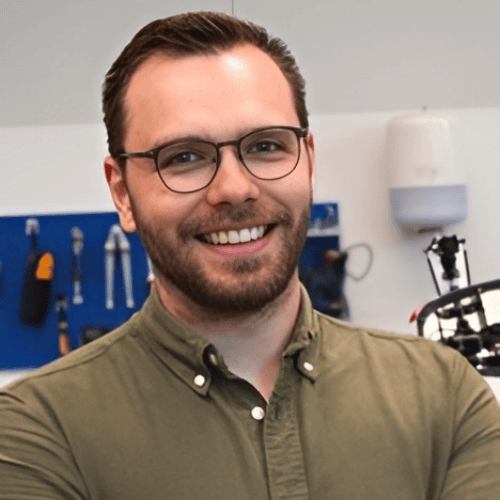SwissDrones uses Autodesk Fusion to design and produce advanced, unmanned helicopters, and looks forward to deploying AI and data analytics seamlessly on the platform.
Founded in Switzerland in 2013, SwissDrones has approximately 50 employees, operating in the same space as the world’s biggest aviation companies like Boeing or Airbus
The company develops advanced, unmanned helicopters equipped with Light Detection and Ranging (LIDAR) technology to perform precise, repeatable infrastructure inspections – for the global market.
Flying drones – or unmanned aerial vehicles (UAVs) – provide many benefits over manned helicopters. For example, they are safer, even under dangerous conditions like bad weather, darkness, or flight over hostile or otherwise unsafe areas.
These drones are also exceptionally sustainable, allowing CO2 emission reduction of up to 90% compared to manned helicopters, and are therefore a significant enabler for a greener future.
At Autodesk University 2025 held in Nashville, Tennessee, in September 2025, the SwissDrones team led by Pol-Victor Gisquet, Team Lead, Mechanical System Integration – Development Engineer, and Alexander Lemus, Program Manager and Head, Office of Airworthiness, shared how they use Autodesk Fusion’s collaborative capabilities to develop exceptional unmanned flying machines such as the SDO 50 V3.

“We currently live in a world where there is an ever-increasing demand for electricity, gas and oil, but the infrastructure is aging, and this requires a lot of attention to maintain it,” said Gisquet. “Traditionally, all those inspections are done by manned helicopters. Way too often, there are deadly crashes.”
That’s where SwissDrones’ solution comes in. Gisquet explained: “We build unmanned helicopters that can precisely repeat flight routes using LIDAR payloads. It can map entire infrastructures and detect the slightest issues or shifts as small as one millimeter. It also reduces CO2 emissions by 90%.”
The Autodesk Fusion advantage
SwissDrones started with Autodesk Inventor 8-9 years ago for 3D mechanical design, but decided to move to Fusion 5 years ago to leverage cloud collaboration and the SaaS subscription model.
Gisquet highlighted the affordable entry price of the software: “I joined SwissDrones 4.5 years ago when Alex was starting the integration of Fusion and the entry price of the license – even though it has increased a little bit since then – is still really much more affordable. It’s in an order of magnitude cheaper than any other CAD software out there, especially for us with aviation requirements.”
SwissDrones now uses Autodesk Fusion software to bring commercial unmanned aerial vehicles (UAVs) to market for various purposes: inspection and monitoring, search and rescue, and aerial surveillance.
Using Autodesk Fusion for design, production, and digital twin management, the company accelerates prototyping and optimizes cost efficiency, while ensuring compliance in a tightly regulated industry.

“Since the beginning, it was very important that we have a single point of truth, but at the same time connect everybody around the globe, and Autodesk Fusion, with its cloud solution, offered a perfect fit for that,” said Lemus.
Recognizing Autodesk Fusion as an ideal platform to develop commercial consumer products from concept to production, the distributed team of 25 engineers and sales personnel use Autodesk Fusion to collaborate effectively on a common goal, making use of PDM and PLM workflows in Autodesk Fusion to document the design and change management processes needed for large designs.
Lemus shared: “We can start with the engineering and design, but also continue with production, maintenance and general configuration control within the same environment. This allows us to release a prototype in a much faster pace to the market, while ensuring high quality and complying to aviation standards.”
Lemus shared: “We can start with the engineering and design, but also continue with production, maintenance and general configuration control within the same environment. This allows us to release a prototype in a much faster pace to the market, while ensuring high quality and complying to aviation standards.”
SwissDrones also uses Fusion to track center of gravity, according to Gisquet. “To track the weight and material of each component to preempt future problems, we have a CNC cutting machine that uses Fusion CAM to manufacture our carbon parts. This allows us to maximize the amount of pieces we can get per plate, giving us better control over time and cost.”
Lemus said: “To meet the strict requirements in the aviation industry, we ensure – with Fusion Manage Extension – that we have releases and configuration control.”
Gisquet added: “This requires us to have a complete digital twin of the aircraft. We need to show variant control. The PLM solution from Fusion Manage Extension is at the heart of this process for us, and we are currently working on expanding it.”
Looking ahead
SwissDrones is looking to expand the use of the Fusion platform to include more data sets beyond just mechanical design, aiming for a more comprehensive configuration control system.
“We want to move towards a seamless workflow from concept to design to manufacturing, with the goal of reducing reliance on external tools like Excel and using Fusion natively for all teams,” said Lemus.
“At the moment, our use of Fusion is focused on the mechanical. We’re really hoping to achieve more than just mechanical design in our configuration control. We would like to add more data sets, because we also have electronics, harnesses and software, so that we can just go to one point of configuration control for production or maintenance.”
The team is also actively exploring and implementing AI and data analytics to enhance productivity, support the design process, and analyze operational data from the deployed fleet of UAVs.
The data includes continual gathering of customer feedback and incorporating it into product development, as well as staying up-to-date with regulatory changes and assisting customers in navigating compliance requirements.
Gisquet concluded: “What keeps me motivated to solve all our daily challenges is knowing that what we are doing is having an impact and has the potential to improve our world.”
